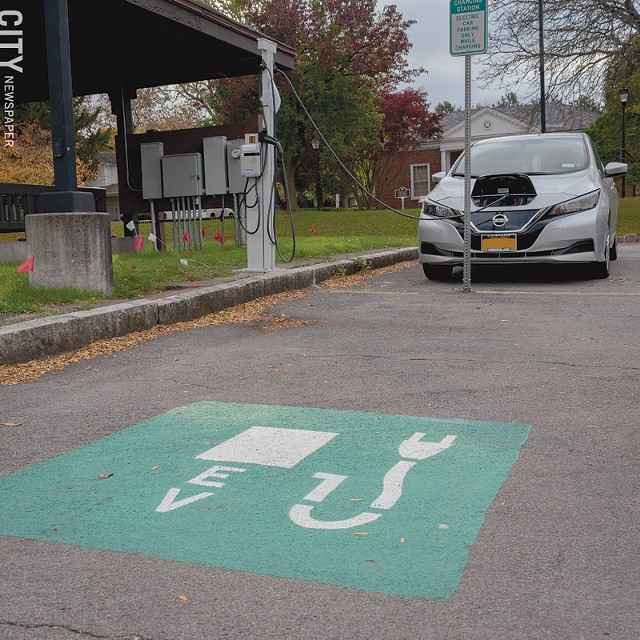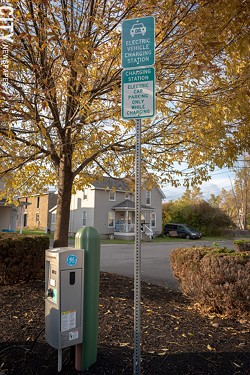Fairport is charged up about electric vehicles.
The 14450 zip code, which covers the village as well as the Town of Perinton, boasts 263 registered electric vehicles, according to data published by the state. Of upstate zip codes, only Pittsford and Ithaca have more, with 293 and 385, respectively.
But Fairport has something that neither of the other two communities have - a municipal electric company that provides residents with low cost power. That's an attractive asset when it comes to vehicles that run on a charge rather than a tank of gas.

- Photo by RENÉE HEININGER
- The Village of Fairport installed public charging stations for electric vehicles in the municipal parking lot at Fairport Landing.
It also puts the village in a unique position to gain insight into drivers' charging practices and needs, and how utilities can best manage the increasing number of chargers connected to their grids. The New York Power Authority is, in fact, partnering with Fairport to do exactly that.
"Right now, we're trying to understand human behavior and how people use these things," says Village Manager Bryan White, who also manages the municipal utility, Fairport Electric.
The partnership is happening under the umbrella of the Power Authority's EVolve NY initiative, through which the state plans to invest $250 million into electric vehicle infrastructure, consumer education, and other programs by 2025. Fairport has been selected to serve as the program's sole "model EV community," White says.
A Power Authority spokesperson declined to discuss the model EV program with CITY because the agency wasn't prepared to make an announcement.
The village and Power Authority will partner on some outreach work, such as test drive events and educating consumers about charging stations, White says.
But data collection and analysis will be a major focus of the model EV community project. The village and Power Authority will get that data by expanding the network of public charging stations and private residential chargers in Fairport Electric territory, White says.
The village currently has three public charging stations and they provide connections for five vehicles. Through the new effort, it'll add 25 public connections, all of which will be metered, White says.
Fairport has also received 50 charging stations to provide to residents for at-home use. They'll be connected to Wi-Fi networks and will feed information to village and Power Authority staff about when people charge their vehicles and how much power they're consuming.

- Photo by RENÉE HEININGER
- Fairport will install additional public electric vehicle chargers in the village as part of a joint program with the New York Power Authority. The program's goal, in simple terms, is to improve electric vehicle infrastructure.
That information will, in turn, help the partners develop practices for managing charging infrastructure on the grid, White says. Because the chargers are network connected, they can be controlled remotely by the utility and turned off during periods of high demand, White says.
The Fairport project is the latest in a series of efforts by local organizations and governments to make Monroe County and its communities friendlier to electric vehicles.
Many of those efforts, such as electric vehicle test drive events, have focused on making drivers and car buyers more familiar with the cars. The Greater Rochester Clean Cities Coalition has coordinated much of that work.
The coalition and local governments have also focused heavily on addressing range anxiety. Some drivers and car buyers can be reluctant to rely on electric vehicles out of fear that they'll end up in situations where they run out of juice before they get where they're going. When people can see and use charging stations at their regular destinations, however, range anxiety becomes less of an issue.
"When I started working on electric vehicles about eight years ago there was nothing," in terms of public charging infrastructure, says David Keefe, the coalition's coordinator. But over the past few years, the organization has arranged for the installation of 90 charging stations across the county.
Rochester installed its first public-use electric vehicle charging stations in 2013 and 2014 at City Hall, the Public Market, and the Port of Rochester. The city has since added stations at the market, the Charlotte Branch Library, Genesee Valley Park, and Cobbs Hill Park. All of those were added through a Power Authority program, says Anne Spaulding, manager of the city's Division of Environmental Quality.
One of the city's goals, says Spaulding, has been to ensure that electric vehicle drivers commuting into the city for work have a place to charge up for their drive home.
The stations have been getting more use over time.
In 2014, the first full year they were online, 119 different vehicles plugged into them, Spaulding says. So far this year, more than 1,000 different vehicles have hooked up, she said.
Countywide, electric vehicles have become increasingly prevalent. There are 2,600 electric vehicles on the road in Monroe County, which is more than any other upstate county, according to state data.
But as more people drive electric vehicles, all the additional charging will place heavier demands on New York's power grid, according to an annual trends report published by New York Independent System Operator, the organization that manages the grid. It projects substantial growth in electric vehicle-associate power consumption over the next 20 years.
Fairport's contributions through its partnership with the Power Authority will shape how utilities manage those demands. They'll help figure out which strategies work — for utilities and consumers — and which don't, White says.
It makes sense, given that Fairport Electric will have to manage these demands itself and that the market for electric vehicles, says White, "is directly right in our backyard."
Jeremy Moule is CITY's news editor. He can be reached at [email protected].